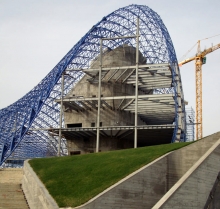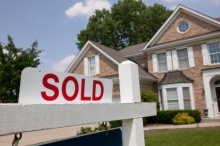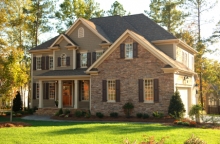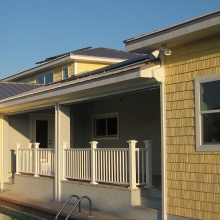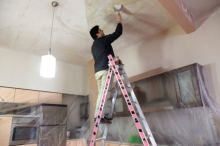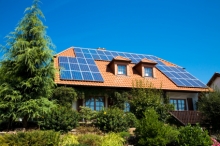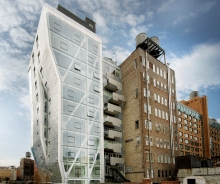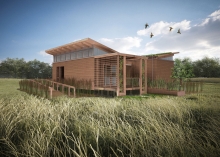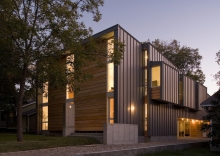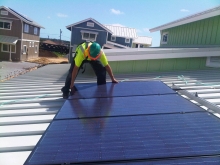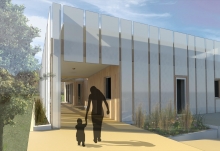Zaha Hadid Architects’ 57,519 m2 (approx. 619,129 sq. ft.) Heydar Aliyev Cultural Centre, a mixed-use venue featuring a conference hall, library, and museum, is scheduled to open in September 2011 in the city of Baku, Azerbaijan.
CSI Project Solutions
Dressing Up for a Quick Sale
When selling, it pays to think like a buyer. The first thing buyers see, and on which they will base their very first buying decision -- to take a closer look -- is the exterior of your home. This is why investments in curb appeal typically have a higher payback than interior upgrades. Remodeling Magazine’s vaunted Cost vs. Value report, an annual survey of improvement costs vs. payback at time of sale, reveals siding as one the best investments, far ahead of upgraded kitchens and baths.
Love the One You're With: Improve your Existing Home
Steep declines in housing prices and stiffer lending requirements have slowed home sales to their lowest levels in decades. As a result, a lot of us have changed our long term plans. Rather than climb the housing ladder any further, we would rather improve our existing home -- the architectural equivalent of “love the one you’re with.”
Transforming Home Ownership with Achievable Greenovations
A Thought Leader’s Home Details How Sustainability Puts ‘Green’ Back in Your Pocket
American housing doesn’t get much more quintessential than a 1968 ranch style home. That’s exactly what eco-entrepreneur Paul Shahriari bought for his family in Cape Coral, Florida -- a yellow ranch clad in stucco and in need of a new roof and windows. His family would eventually come to call it their Lemonade House. The house has also been reborn as the Florida High Performance Green House, a demonstration home for Shahriari, a sustainability consultant and founder of three companies.
To Move or To Improve?
If Shakespeare were alive today, he may have asked the more pressing question, “To move or to improve?” Either way, the choice usually means a change for the better, so it’s more about “why to,” “when to,” and “how to" move or improve rather than “if to” do either, because, while sellers remain shell-shocked, today’s home-hunters and remodeling customers are in for a pleasantly plentiful supply: It’s a buyer’s market.
Green Homes vs Traditional Homes
In recent years, the U.S. home building industry has undoubtedly seen its troubles. The downturn in the economy has forced many builders to rethink how they approach their market now that it is much smaller. In many cases those builders have chosen to address the increasing demand for green homes. By offering green homes, many builders are now meeting their customers’ needs for energy- and water-efficient homes with a healthier environment and financial benefits. What once was a niche can now be seen as mainstream. According to the United States Green Building Council, their LEED for Homes program has certified 10,000 homes since it started in 2008. This sounds very impressive, but what is a green home, and what are the benefits compared to a traditional home?
This summer, the second portion of the High Line will open between West 20th and 30th Streets along the west side of Manhattan. An elevated railway had been abandoned for decades, a piece of urban detritus with grass growing between the tracks. Now it is teeming with wildflowers, having recently been transformed into an urban park known as the High Line, designed by James Corner Field Operations and Diller Scofidio + Renfro. The surrounding West Chelsea neighborhood, a popular location for art galleries and nightclubs, has experienced a surge in development in the form of luxury residential towers, pressing westward to claim views of the High Line. The HL23, located at West 23rd Street and 10th Avenue, not only succeeds in pushing to the front of the line, it billows over.
2011 Solar Decathlon: University of Maryland's WaterShed
Solar Decathlon homes typically focus on the obvious – using energy from the sun. Students of the University of Maryland chose instead to highlight another precious resource often taken for granted: water. Their design, titled WaterShed, was inspired by the Chesapeake Bay watershed, the largest estuary in the United States with an area of 64,000 square miles spanning the states of Maryland, Delaware, New York, Pennsylvania, Virginia, and West Virginia. Suburban sprawl combined with the lack of stormwater management has threatened these natural ecosystems. WaterShed offers a sustainable model for living in the area, incorporating a range of water features and living elements. Leah Davies, who serves as one of the team leaders, explains that the home "mimics the cyclical nature of the Chesapeake Bay ecosystem by demonstrating the hydrologic cycle on a micro-scale."
Asphalt Pavement Solar Collectors: The Future is Now
For several years universities in the United States have been looking into the feasibility of using asphalt pavement to collect solar energy, or, more correctly, to harvest the solar energy that asphalt pavement is already collecting. Researchers have found that the technology exists for harvesting this energy, and its implementation may not be that far off.
House of the Month: Captured Spaces: An Exercise in Modernism
The Fairfield House, designed by Webber + Studio, is located on a tree-lined street in the Austin, Texas, neighborhood of North Hyde Park. The Hyde Park Historic District is listed in the National Register of Historic places, and the area’s popularity has been growing in recent years due to its proximity to the University of Texas. In many respects, the 3,180 sq. ft. home, an Architectural Record House of the Month in 2009, draws upon the district’s rich architectural traditions, just as its neighbors do. In response to Texas’s hot, humid climate, for example, the house is separated into small building masses that are open to ventilation. A breezeway – another classic architectural element – connects the front and the back portions of the building, but that is where the nod to tradition ends. In every other aspect of its design, the Fairfield House is an exercise in modernism.
Building Green on a Budget: Advice from Leading Architects
What are the best ways to build sustainably within budget constraints? We asked several leading architects for insight on this timely issue. Their collective advice on building green on a budget is to return to the fundamentals of good design and choose climate-appropriate materials that offer a quick payback.
2011 Solar Decathlon: The Ohio State University
Returning to the Solar Decathlon for the second consecutive competition, The Ohio State University team is building on the lessons learned from a Top 10 finish in the 2009 competition with a focus on efficient urban living. Designed as an urban infill house that could fit anywhere in Columbus, Ohio, enCORE is a 900 sq. ft., two-bedroom house that layers programmatic living spaces in an effort to recapture the spatial efficiencies of older homes. Abbie Faust, a Master's candidate in Architecture, explains, “We really wanted to emphasize how people can live in a smaller footprint. Our house condenses the family space by not losing the function, but emphasizing the core, of our house.”
